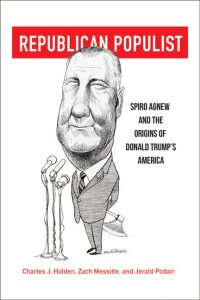REPUBLICAN POPULIST: SPIRO AGNEW AND THE ORIGINS OF DONALD TRUMP’S AMERICA
 REPUBLICAN POPULIST: SPIRO AGNEW AND THE ORIGINS OF DONALD TRUMP’S AMERICA, by Charles J. Holden, Zach Messitte, and Jerald Podair (Charlottesville: University of Virginia Press, 2019)
REPUBLICAN POPULIST: SPIRO AGNEW AND THE ORIGINS OF DONALD TRUMP’S AMERICA, by Charles J. Holden, Zach Messitte, and Jerald Podair (Charlottesville: University of Virginia Press, 2019)
Reviewed by Jon Bloom, a member of the Board of the New York Labor History Association
Spiro T. Agnew was a reactionary comet who streaked across the American political firmament. Vice-President to Richard Nixon from 1969 to 1973, when Agnew resigned in disgrace, he is now almost completely unremembered. Republican Populist convincingly makes the case that Agnew’s importance has been overlooked. Its three co-authors view him as a key figure in transforming the Republicans from the party of the elite into that of the anti-elite, no longer the champions of the “economic royalists” (Franklin Roosevelt’s zinging label) but of middle-class suburbanites, including workers.
Like Scott Walker of Wisconsin in our era, “Ted” Agnew jumped within a few years from County Executive (of Baltimore) to Governor of Maryland. He started out as a moderate Republican, winning a race for Governor in 1966 against an openly racist Democrat, and in 1968 he initially supported New York Governor Nelson Rockefeller’s comparatively liberal campaign for the Republican presidential nomination against Nixon and Ronald Reagan. But Agnew’s combative style, particularly in response to Black protest, caught the eye of conservative Patrick Buchanan, who recommended Agnew to Nixon as his running mate. “Spiro who?” seconded Nixon’s successful election appeals to “the forgotten Americans – the non-shouters, the non-demonstrators.”
In the new administration’s first year, Agnew quickly came into his own. In November 1969, when Nixon responded to a massive antiwar march on Washington with a television speech appealing to and claiming the support of “the silent majority,” Agnew took to the airwaves with speeches attacking the major television networks (only three, in those long-ago pre-cable days) and newspapers, and a new star was born. Nixon staff writers Buchanan and William Safire wrote Agnew’s derogations of the “nattering nabobs of negativism,” the “pusillanimous pussyfooters,” “impudent snobs,” student radicals, and coddling college administrators.
Although Nixon actually detested Agnew and considered him lazy and incompetent, he called Agnew his “bayonet” and didn’t dare replace him on the 1972 Republican ticket. But soon after their landslide re-election victory (by 520 to 17 electoral votes), it emerged that Agnew, the champion of hard work, patriotism, and law and order, had been demanding and receiving payoffs from building and highway contractors as Governor of Maryland and even as Vice President. In October 1973, faced with the likelihood of prison, Agnew agreed to resign and pled no contest to tax evasion charges. (This remarkable story is recounted in enthralling detail in Rachel Maddow’s 2019 podcast Bag Man.) Nixon’s own downfall was well underway, and the Agnew scandal was quickly forgotten in the shadow of Watergate. A few years later, Agnew briefly recaptured notoriety for comments about “Zionist influences in the U.S.” and alleged Jewish control of the media, in a published novel and subsequent interviews. (Safire disowned him, Buchanan didn’t.)
The three authors tell this sorry story with economy and verve, but the purpose of their book is not to expose Agnew as a phony paragon of virtue. Rather it is to chasten those who underestimated his appeal and his abilities to speak to the fears and resentments of many Americans – which brings us to the book’s subtitle and its final chapter, “From Agnew to Trump.”
The authors believe that Agnew’s “brand of conservative populism…has echoed through the Republican party for the last half century and…culminated in the 2016 election of Donald Trump.” Noting that “Trump has been overcompared to a variety of polarizing political figures of the twentieth century,” and that others “also contributed to the rise of the anti-elite, populist wing of the GOP since the 1960s,” they see Agnew as a key forerunner.
One can imagine Agnew as an enthusiastic Trump supporter. Both had an affinity for foreign tyrants, a marked contempt for the press (even as they were objects of its fascinated attention), undemocratic inclinations (Agnew regarded civil disobedience as illegitimate and criminal), and a joy in rousing exclusively friendly crowds in “off-the-beaten-path venues,” particularly small cities in the South and Midwest. Agnew had a natural ability to bring out anger and discontent and to pitch himself and his party as champions of the real underdogs, allegedly oppressed and taken advantage of by the whining poor and their “elite” enablers. Agnew reshuffled the class images of the two major parties, projecting the Republicans as the party of the deplored average people against the effete Democrats. Other politicians including Nixon certainly worked at this, but Agnew was perhaps the most aggressive and successful until the arrival of our current President. Republican Populist recaptures Agnew’s moment and makes the case for his lasting significance.
